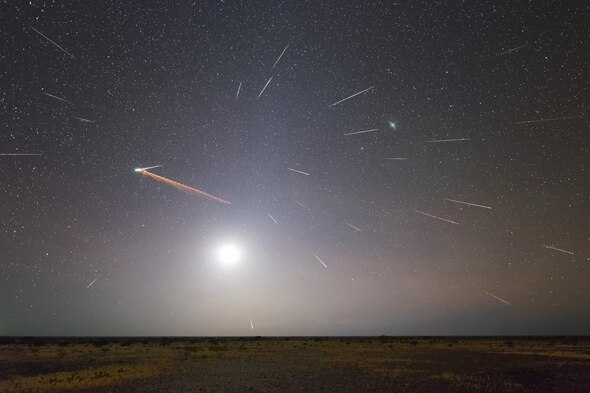Create a free profile to get unlimited access to exclusive videos, sweepstakes, and more!
The Best Meteor Shower You’ve Never Heard of: The Quadrantids

The new year is still shiny and new, and itâs off to a good start: The annual Quadrantid meteor shower peaks tomorrow! With no Moon to interfere with it, you could have as many as 100 or more meteors per hour, so itâs worth a shot taking a look if you can.
The Quadrantidsânamed after the constellation Quadrans Muralis, which no longer exists (think of it as having been either rezoned into new constellations, or gerrymandered)âpeak pretty rapidly, going from essentially nothing to the maximum number per hour in about 12 hours! Most other showers, like the more-famous Perseids, peak more slowly, taking days to build up.
What this means is that itâs best to get out and look when the shower is at its max. In this case, thatâs predicted to be at 19:30 UTC on Jan. 3, or 14:30 EST. Thatâs in the afternoon for the U.S., so it looks unlikely we Americans will get a good view (east Asia has the best view, given the timing). However, I suggest taking a look anyway! You never know, and predictions for showers have been known to be off in the past. Pre-dawn and post-sunset on the 3rd is probably your best shot, but Iâm guessing a bit here. See below for more on how to view it.
But First, a Note From a Parent
This shower is a bit odd. First, itâs one of only two (the other being the Geminids) that has an asteroid as its parent body! Meteors are little bits of debris (rock and dust) that enter our atmosphere and burn up (the solid bit is called a meteoroid, and if it hits the ground, it becomes a meteorite). Comets shed this sort of detritus, leaving it behind in a trail that shares the cometâs orbit around the Sun. When the Earth plows into this stuff, we get showers.
However, the likely source of the Quadrantids is the asteroid 2003 EH1, which has a very similar orbit as the meteoroids. It may be a dead comet, one that lost all its ice and is now just composed of rockâ3200 Phaethon, the parent of the Geminid meteor shower, is likely a dead comet, too.
Keep Watching the Skies
So how do you observe them? Well, I have a guide to meteor shower viewing thatâll help. The generic instructions still apply: You need wide open skies, be away from city lights, keep warm, and so on. However, one thing that changes is the radiant ⦠so let me take a sec to explain.
The meteoroids form a stream in space, and the Earth is ramming through them. This means they all appear to come from one spot in the sky, radiating outward from it (hence the term radiant). Itâs like driving through a tunnel and seeing the lights appear to come from a spot directly ahead of you. In the picture at the top of this post you can see that effect; it shows the Eta Aquarids, which peak in May. They all appear to converge to a point in the sky, which is simply a perspective effect.
In the case of the Quadrantids, the radiant is near the north pole of the sky, between the Big Dipperâs handle and the constellation of Draco. This online sky atlas might help you find it. For most northern hemisphereans, the Big Dipper is low to the horizon after sunset, and Draco to the left. Just before sunrise the Big Dipper is high to the north (itâll look upside down), and Draco to the lower right. Face that way if youâd like, but usually your best bet is to simply have as much sky as possible visible (no trees or buildings in your way) and face up.
Other websites also have useful info; try Sky and Telescope, Universe Today, and TimeandDate.com for more.
Meteor showers are a crap shoot; you might see lots, or just a few. However, unlike at a casino, pretty much no matter what happens you win in the end: You spend a night out under the stars, watching the sky. You might even see a few satellites. And, if things work out, you can watch as some pieces of interplanetary jetsam slam into the Earthâs atmosphere at 40 kilometers per second, converting their substantive kinetic energy into light and heat a hundred kilometers above your head.
How can you resist?














